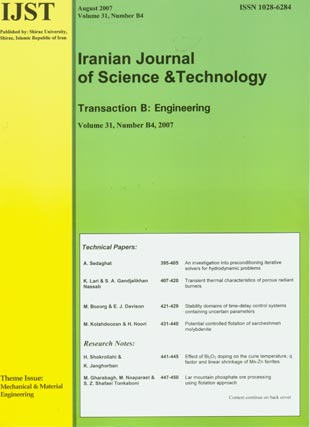فهرست مطالب

Iranian Journal of science and Technology (B: Engineering)
Volume:31 Issue: 4, August 2007
- Mechanical & Materials Engineering
- 70 صفحه،
- تاریخ انتشار: 1386/07/01
- تعداد عناوین: 6
-
-
صفحات 395-405Two Krylov subspace iterative methods, GMRES and QMR, were studied in conjunction with several preconditioning techniques for solving the linear system raised from the finite element discretisation of incompressible Navier Stokes equations for hydrodynamic problems. The preconditioning methods under investigation were the incomplete factorisation methods such as ILU(0) and MILU, the Stokes preconditioner, and the Elman-Silvester block triangular preconditioner. It is observed that the GMRES solver with the Elman-Silvester preconditioner provides faster convergence than the other methods studied here.
کلیدواژگان: Krylov subspace، Navier Stokes، preconditioned iterative methods، finite element -
صفحات 407-420The transient heat transfer characteristics of porous radiant burners are analyzed in this work. A one dimensional model is used to solve the governing equations for porous medium and gas flow before the premixed flame to the exhaust gas. Combustion in the porous medium is modeled as a spatially dependent heat generation zone. The solid phase is assumed to be absorbing, emitting and scattering, while the gas phase is considered transparent to radiation. In order to analyze the thermal characteristics of porous burners, the coupled energy equations for the gas and porous medium based on the two–flux radiation model are solved numerically and the effect of various factors on the performance of porous radiant burners are determined. A comparison has been made between the present numerical results and those reported by other investigators to validate the simplification for the radiative effect.
کلیدواژگان: Porous radiant burners، two- flux model، transient condition -
صفحات 421-429In this paper, the stability of time-delay control systems subject to parameter perturbation is investigated. The maximum allowable perturbation in the parameters of the system that maintains stability is determined. The parameters are allowed to perturb inside an lp-hypersolid (such as a hyperellipsoid, a box or a diamond in a multi-dimensional space) around their nominal values, and the size of the largest hypersolid that preserves the stability conditions is computed. The stability is characterized as the location of the closed-loop poles inside the symmetric regions in the complex plane (so-called “D-stability”). A direct numerical method is developed for the calculation of these stability margins. The method requires plotting a distance function over the contour of the stability region and finding its minimum. To illustrate the method, a numerical example is provided.
کلیدواژگان: Robust stability، parameter uncertainty، time، delay systems، quasipolynomials -
صفحات 431-440Molybdenite flotation in the Sarcheshmeh Copper Complex was studied as a function of pulp potential, controlled using two types of sodium sulfide, a mineral origin and a chemical nature. Air and either plant or laboratory nitrogen were used as flotation careers. Potential readings took place in rougher cells, as it was proved to be vital in the molybdenite circuit. Results showed that, at reducing potentials between -525 and -575 mv, the highest molybdenum recovery of 93% and the lowest copper recovery of 4-15% can be achieved. These potentials did not change considerably by adding extra amounts of sodium sulfide. At more oxidizing potentials, i.e. more than -450 mv, copper recovery increases while the recovery of Molybdenite drops.
کلیدواژگان: Flotation، molybdenite، copper sSulfides، pulp potential، sodium sulfide، sarcheshmeh copper complex -
صفحات 441-445Bi2O3 was added to the Mn-Zn ferrite (52 mol % Fe2O3, 34 mol% MnO, 14 mol% ZnO) in the amounts of 0.03, 0.08, 0.2, 1 and 5 wt%. Q factor, Curie temperature and linear shrinkage were investigated. Several sintering conditions were practiced. The optimum sintering condition (1200 °C for 1 hour) was determined based on the maximum value of the Q factor of undoped ferrite. The net magnetic moment, Curie point and shrinkage behavior of the material were influenced by Bi2O3. Results showed that in small additions of Bi2O3 (0.03 wt %), the Q factor was the maximum, and with increasing Bi2O3, the linear shrinkage decreased. The Curie temperature changed in two stages; it increased in the first where Bi2O3 was below 1 wt%, and then decreased above this value.
کلیدواژگان: Mn، Zn ferrite، Bi2O3، Curie temperature، Q factor، linear shrinkage -
صفحات 447-450The sample of Lar Mountain Phosphate deposit which is located in the southwest of Iran, was studied to upgrade its phosphate grade. The results obtained from mineralogical studies showed the presence of apatite, CaO, Al2O3, Fe2O3 and SiO2, in which carbonate was detected as the main gangue. Two sets of direct and reverse flotation tests were performed using samples from this deposit with 10% P2O5. In phosphate flotation (direct approach), the samples were conditioned with sodium silica, oleic acid-fuel oil and Armac T-fuel oil. The direct flotation at pH=9.2 yielded a product with 23.2% of P2O5 and 75.16% recovery. The reverse flotation tests were carried out at pH=5.2, with floating carbonate and pulp de-oiling, using H2SO4 and wash water, and phosphate was then floated from siliceous gangue. In the second sets of the reverse approach, depressing the phosphate and floating silica with Amines in natural pH were done. However the best concentrate assay was 31.2% P2O5 with a 71.12% recovery, which was obtained from reverse tests.
کلیدواژگان: Mineral processing، phosphate processing، flotation، Lar mountain deposit

